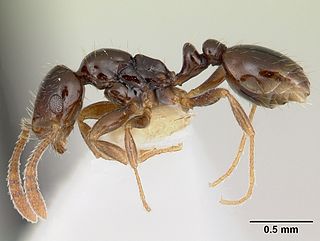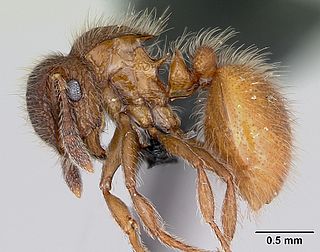Megalomyrmex symmetochus is a species of ant in the subfamily Myrmicinae. It is native to Panama.

Megalomyrmex is a genus of ant in the subfamily Myrmicinae. The genus is known only from the Neotropics, where some of the species are specialized parasites or predators of Attini.

Cyphomyrmex is a genus of fungus-growing ants found primarily in South and Central America. However, some species do come up to the southern portion of North America. They grow a variety of fungi in the tribe Leucocoprineae. Most fungal gardens are grown in small nodules, some species to cultivate entire mycelium, though. Colonies are monogynous and are relatively small with about 100 workers on average.

Agroecomyrmecinae is a subfamily of ants containing two extant and two fossil genera. The subfamily was originally classified in 1930 by Carpenter as Agroecomyrmecini, a Myrmicinae tribe. Bolton raised the tribe to subfamily status in 2003, suggesting that Agroecomyrmecinae might be the sister taxon to Myrmicinae. It has since been discovered to be one of the earliest lineages of ants, a clade from the basal polytomy for all ants. In 2014, the subfamily was expanded to two tribes. The tribe Ankylomyrmini was moved from the subfamily Myrmicinae to Agroemyrmecinae.

Adelomyrmex is a genus of ants in the subfamily Myrmicinae. Species of Adelomyrmex are small, litter-inhabiting ants most often collected in Berlese and Winkler samples. Although the genus and its relatives have a pantropical distribution, Central American cloud forests are the only places where they are abundant and diverse.

Meranoplus is an Old World genus of ants in the subfamily Myrmicinae. With over 80 valid species, it is predicted that over half of the Meranoplus diversity remains undescribed, most of these from Australia.
Megalomyrmex mondabora is a Neotropical species of ants in the subfamily Myrmicinae. Known from Costa Rica. In Costa Rica this species occurs in wet forest habitats, typically in mature rainforest. Collections are from sea level to 800 m elevation on the Atlantic slope of the Cordillera Volcanica Central, Cordillera de Talamanca, and Cordillera de Guanacaste. It is a specialized nest parasite of attines and is found most often in nests of Cyphomyrmex cornutus. It cohabits with C. cornutus in their nests, feeding on both host brood and the host's fungal symbiont.
Megalomyrmex mondaboroides is a Neotropical species of ants in the subfamily Myrmicinae. Megalomyrmex mondaboroides occurs in lowland wet forest habitats in Panama and Costa Rica. Colonies have been collected in the nests of small attines, primarily Cyphomyrmex costatus and Apterostigma goniodes. In Costa Rica a worker was collected in a Winkler sample of sifted leaf litter.
Megalomyrmex wallacei is a Neotropical species of ants in the subfamily Myrmicinae. Megalomyrmex wallacei can be found in Brazil, Guyana, Colombia, Costa Rica. This species occurs in mature wet forest, usually low-elevation rainforest. Brandão (2003) reports the species nesting under leaves on the forest floor, in colonies of up to 300 workers.
Megalomyrmex reina is a Neotropical species of ants in the subfamily Myrmicinae. Described in 2010, this species is known only from queens from Costa Rica. The fact that it is known only from queens is reflected in the name.
Megalomyrmex modestus is a Neotropical species of ants in the subfamily Myrmicinae. Known from Costa Rica, Panama, Colombia, Venezuela.

Megalomyrmex drifti is a Neotropical species of ants in the subfamily Myrmicinae. The species is widespread in tropical South America, north through Central America to southern Mexico.
Megalomyrmex foreli is a Neotropical species of ants in the subfamily Myrmicinae.

Megalomyrmex incisus is a Neotropical species of ants in the subfamily Myrmicinae. The species is known from southern Mexico south to central Brazil and Peru.
Megalomyrmex miri is a Neotropical species of ants in the subfamily Myrmicinae. Known from Costa Rica. This species is known only from the type specimens and has no biological data. It is extremely similar to M. wettereri in color, size, shape, measurements, and pilosity. It differs in having a complete foraminal carina and some transverse rugosities on the anteroventral petiolar process.
Megalomyrmex wettereri is a Neotropical species of ants in the subfamily Myrmicinae. Megalomyrmex wettereri is known from two lowland rainforest sites: Barro Colorado Island in Panama and La Selva Biological Station in Costa Rica.

Megalomyrmex silvestrii is a Neotropical species of ants in the subfamily Myrmicinae. Megalomyrmex silvestrii is widespread in the mainland Neotropics from Mexico to northern Argentina. This species occurs in moist to wet forest habitats, from sea level to 1100 m elevation. It nests in small chambers in rotten wood or opportunistically in other small cavities in the soil. Colonies have been found in small attine nests and alone, suggesting it is a facultative predator of small Attini.
Megalomyrmex nocarina is a Neotropical species of ants in the subfamily Myrmicinae. Megalomyrmex nocarina occurs in mature wet forest habitats of the Atlantic slope of Costa Rica. It occurs from near sea level to 1110 m elevation. It is known exclusively as isolated workers in Winkler samples of forest floor litter.

Meranoplus radamae is a Malagasy species of ant in the genus Meranoplus. The species diurnal.








